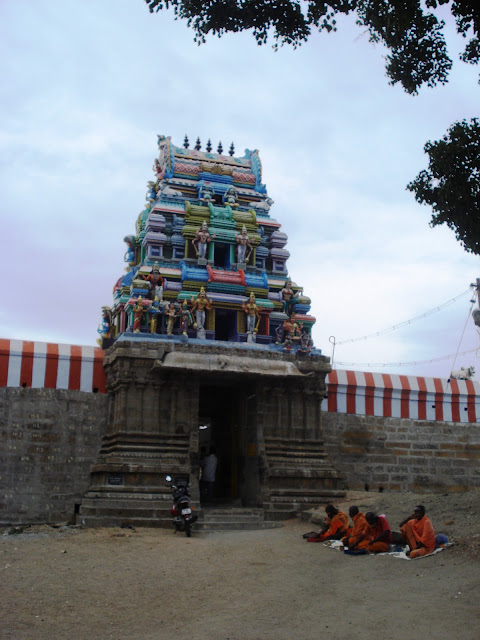Brahmapureeswarar Temple, Thirupattur – The Temple
The Temple has a five level Raja Gopuram facing
east. On entering the temple, one can see a beautiful dwaja sthamba, going
further Nandi resides in a Veda Mandapam which is covered with a Rudraksha
Pandhal. Nada Mandapam is the next mandapam (Hall) following Veda Mandapam is
also unique as it has seven pillars which can play the Saptha swaras. Crossing
this Mandapam will take you to the main shrine of Lord Shiva.
Presiding Deity is called as Lord Brahmapureeswarar in
the form of Swayambu Lingam and Mother is known
as Brahmanayaki / Brahma Sampath Gowri. The antiquity of
the temple seems to be older than that of the Thanjavur temple. When devotees
touch the Nandhi (the bull vehicle of Lord Shiva), a feeling of touching a real
and live bull is experienced by them. On the Pradosha day (13th day either from
New Moon or Full Moon days), the crowd is huge to have the Nandi touch and
experience.
There are seven entrances to cross over to reach the
Sannadhi of Brahmapureeswarar. He is called so since he changed the destiny of
Brahma. Usually in temples, the devotees stand on both sides of the main
deity and worship. In this temple, it is important that the devotee falls
within the direct deeksha of Lord Brahma. Therefore, they are asked to
stand directly in front of him so that their destiny can be changed for the
better. A door way to the right on the first prakaram leads to the Amman temple
and Nandavanam.
The second Praharam has the Samadhi of Patanjali, Brahma
sannidhi is in front of the Adhishtanam. This praharam also has various
sannidhis for Ganesha, Murugan, Saptha Kannikas, Gajalakshmi, Navagrahas. The
Shotasalinga (with 16 stripes) worshipped by Lord Brahmma is placed in a
separate hall in the temple. The roof is made of wood. This is the place Lord
Shiva relieved Brahmma of a curse.
People go around the temple on the ‘Guru Brahmma-Guru
Vishnu’ mantra principle. This is a rare form in the temple. In the entrance
hall, the statue of Sarabeswara quelling the fury of Narasimha is splendidly
sculpted. The very stepping into the temple ensures all prosperity to the devotee.
In one Mandapam, the entire Narasimha Avatar episodes are beautifully sculpted.
The musical pillars in the temple represent the story of Ravana attempting to
lift Mount Kailash and begging Lord Shiva’s pardon with his Sama Gana singing
skill.
Sthala Vriksham
is Makizhamaram. Theertham associated with this temple are Brahma Theertham,
Shanmuga Nadhi and Bahula Theertham. There is a similarity between this temple
and Uthamarkovil – here also there are separate shrines for Brahma, Shiva and
Vishnu (in the form of Narasimha). This temple is an important abode for
Jupiter as Brahma is the authority for Jupiter. Hence those having bad
positioning of Jupiter in their horoscopes, pray here to get relief.
Brahma Shrine:
For
brief details, please refer below link;
12 Shiva Lingams:
For
brief details, please refer below link;
Patanjali Jeeva Samadhi:
For
brief details, please refer below link;
Vyagrapureeswarar
Jeeva Samadhi:
For
brief details, please refer below link;
Other Shrines:
The
temple has shrines for Lord Vishnu in Narasimha form and Chandikeswarar. The Shrine of Lord Dakshinamurthy is
adjacent to the Shrine of Lord Brahma in the southern praharam of the Temple. There
is a separate Sannathi for Devi Gajalakshmi in the inner praharam of the
Temple. Lord Kala Bhairava Shrine is situated in the inner praharam, as one
turns right before entering Sri Brahmapureeswarar Shrine. The Navagraha Shrine
is situated just before the entrance to the Nandavanam (Temple Gardens) in the
first praharam of the Temple.
Saptha
Mathargal deities are near the Jeeva Samadhi of Maharishi Patanjali. Lord
Shanmuganathar Shrine is located near Karpaga Vinayakar Shrine in the inner
praharam of the Temple. Lord Surya Shrine is situated in the inner praharam of
the Temple, as one turns right before entering Sri Brahmapureeswarar Shrine. There
are seven Vinayakars in this temple which is also having seven entrances,
either signifying seven days or Saptha mathas.
Brahma Sampath Gowri Shrine:
Mother
is called as Brahma Sampath Gowri. Devi Parvathi gave back Lord Brahma all his
sheen. And hence the Devi here is called Brahma Sampath Gowri. The Devi Shrine
is situated adjacent to Brahmapureeswarar Shrine on the way to the Nandavanam
(Temple garden). This is a separate temple situated next to main temple complex
in the north side. The Mother idol is huge, beautiful, full of glow and luster
and she is in standing posture. The temple is simple with a garba griha and
various female Koshta vigrahas.
Sanctum Sanctorum:
For
brief details, please refer below link;
Theerthams:
Brahma
Theertham, Shanmuga Nadhi and Bahula Theertham are the major Theerthams
associated with this Temple. Brahma Theertham is the pond from which Lord
Brahma took water for performing puja to the Dwadasa Lingams. Brahma Theertham is
a beautiful temple tank with steps on all 4 sides. Brahma Theertham is located
in Nandavanam adjacent to the Ambal shrine. Bahula Theertham is located to
north east of the Temple. The temple tank is the oldest rain water harvesting
tank and the ingenuity in the construction is laudable. Shanmuga Nadhi is
located to the east of the temple, flows from the north to south similar to
Ganges.
Sthala Vriksham:
The Sthala
Vriksham is Magizha maram which is about 150 years old and is found in the
complex outside the temple which houses 7 out of the 12 lingams. It is
believed that Sage Pathanjali often left his physical body and stayed in the
astral form for many days in this Magizha maram and performed penance.
Vidhiyai Mattriamaikkum Varadharaja Perumal Temple:
There is
another temple named Varadharaja Perumal temple, which is situated about 2 kms
from Brahmapureeswarar temple, he is also called as “Vidhiyai Mattriamaikkum
Varadharaja Perumal”.








































